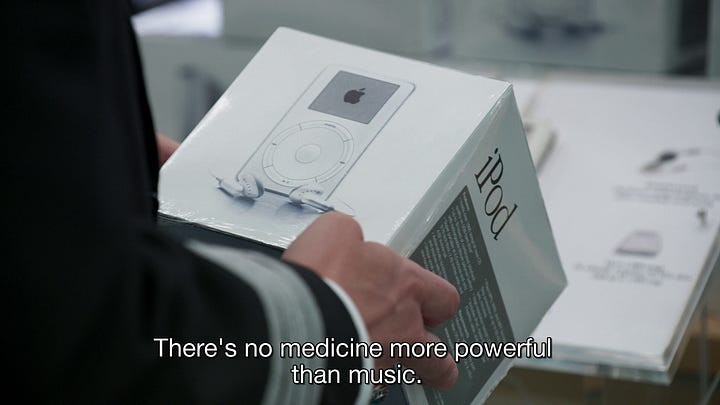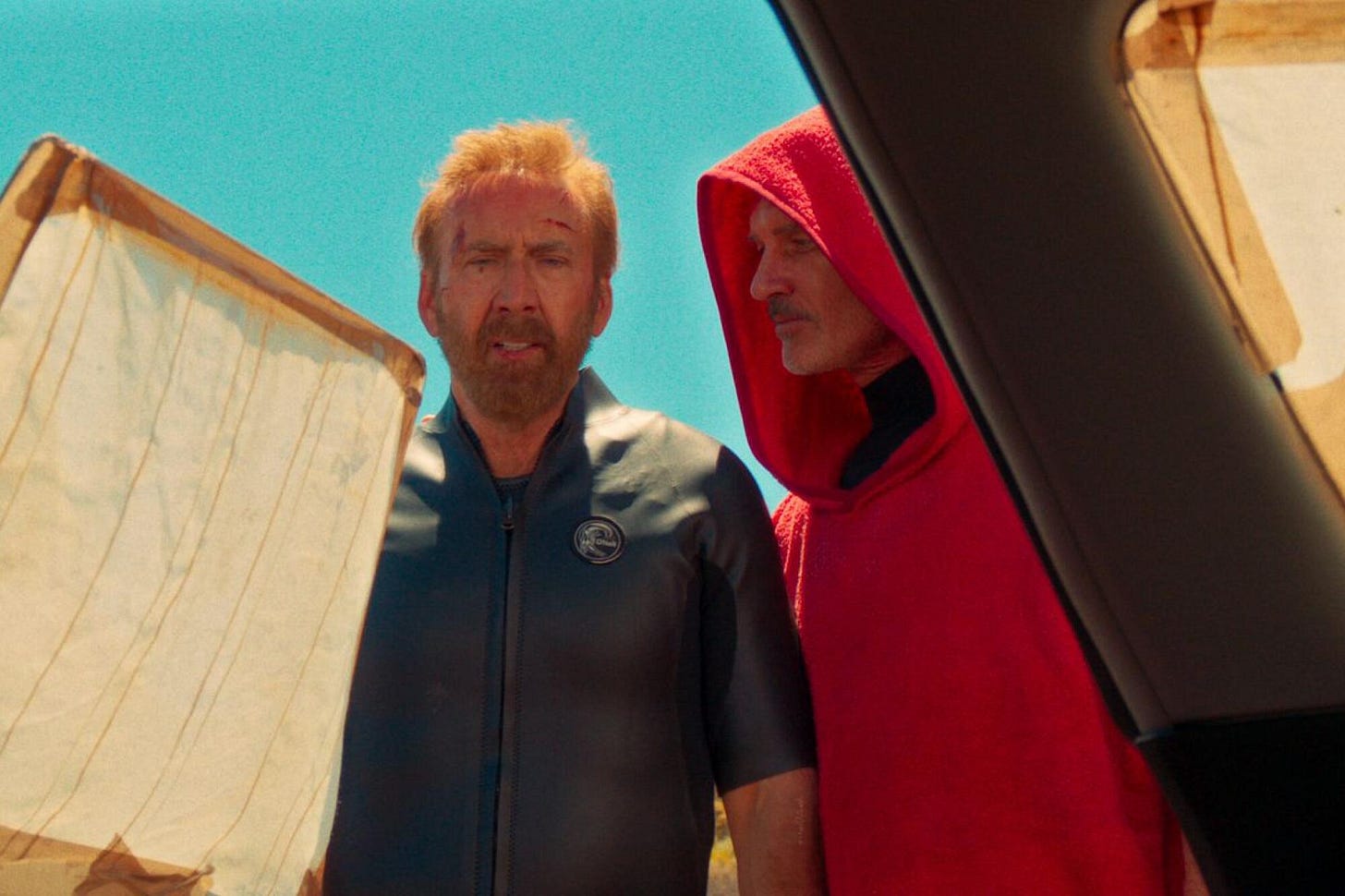Issue #378: The Films of IFFBoston
Early warning. The Paradox Newsletter Movie Marathon is back.
I’ll be screening Graveyard of Honor (1975), Yakuza Graveyard (1976), and Graveyard of Honor (2002). We are going deep.
I finished Clair Obscur: Expedition 33 (2025) this weekend. Believe the hype. The game is excellent. It delivers both in terms of engaging gameplay and an outstanding story.
This week, my topics include The Rehearsal and some films I saw over the past week and a half. Two of the films were screened as part of IFFBoston.
Go Celtics.
The Fragility of Memory in “Pilot’s Code”
In The Rehearsal (2022), Fielder presents himself as a fastidious adherent to the facts of one’s memory. Though recall can be flawed, Fielder doesn’t treat it that way. Instead, he embraces what one recalls and recounts as faithful to the facts. In last week’s episode, “Star Potential,” Fielder shows the limits he sets to his rehearsals based on what one can recall. As he guides the performer playing him through his email exchange with Paramount, because he can’t remember whether he was at home or in his office when reading the emails, he puts the performer in a massive, empty, dark space.




It is particularly significant, then, that Fielder diverges from memory’s fidelity in “Pilot’s Code.” The premise of the episode confronts the opposition between nature and nurture, decidedly embracing the latter as the most determinative of behavior.


In an attempt to internalize the characteristics that contributed to Chesley “Sully” Sullenberger’s safe landing of a damaged airplane in 2009, Fielder uses Sullenberger’s memoir, Highest Duty (2009), as source material for a complex reenactment of Sullenberger’s life.
Fielder, however, finds himself chafing against what he perceives are absences in Sully’s life story. He attributes these omissions to the possible risk of Sully having his “medical certificate” revoked, something Fielder presents as a disincentive for pilots to seek talk therapy. Trying to fill these gaps, Fielder invents a lot: Sully’s relentless use of an iPod and the idea of a “pilot’s code.” The supposed pilot’s code, for which the episode is named, is entirely Fielder’s invention. It’s a code of silence, a norm that would prohibit a pilot from disclosing rule violations or misbehavior.
The idea of a pilot’s code is structurally analogous to therapeutic confidentiality, but transgressing the code might involve someone disclosing that another pilot is undergoing talk therapy. Fielder creates a complex nexus of ideas here, with the iPod and music serving as an alternative to therapeutic intervention.


In Fielder’s assessment of Sully’s black box recording of the averted crash, he notes a twenty-three second gap. In Fielder’s reenactment of the heroic landing, he fills that twenty-three seconds by listening to the chorus of Evanescence’s “Bring Me to Life,” the music therapy that leads Sully to ask his co-pilot, “got any ideas?”
Fielder-as-Sully invokes the pilot’s code to maintain the secrecy of his iPod listening at the critical moment. But the broader, and surprisingly earnest, critique of the episode is of the FAA’s restrictive mental health policies. From Fielder’s perspective, pilots seeking therapy would make them more likely to collaborate with their co-pilots in desperate situations.
This criticism, however, is found on Fielder’s interpretation of what’s not included in Sully’s memoir rather than what the memoir actually says. By turning away from the strict adherence to someone’s testimony and recollection, Fielder is able to interlink the ideas of a (made up) pilot’s code, therapy’s benefits, and music as an insufficient but moderately effective alternative to talk therapy.
Echoes of Synecdoche, New York (2008) are evident in all of The Rehearsal, but particularly striking in this episode. “Pilot’s Code” seems to also deal with the potential danger of over-investment into a particular ideal or restricting one’s capacity for thought based on the limitations imposed by the letter. This episode unbinds Fielder’s thought, but it remains to be seen whether or not his imagination serves to enhance his rehearsals or derail his ambitions entirely.
Lorcan Finnegan’s Radical Critique of Wealth in The Surfer
I don’t think of myself as a critic who regularly reads films as an allegory for something largely absent from the text1. But I have exactly such a reading of Lorcan Finnegan’s The Surfer (2025), a film that obviously resembles Fight Club (1999) and less obviously resembles work like The White Lotus (2021) or Infinity Pool (2023). The latter resemblances are what I find most significant. The Surfer is a movie that manages to anatomize the culture of the haves without excessively glorifying their lifestyle, as some argue of The White Lotus. It is a valuable reminder from Finnegan that there is a way to examine the social space of wealth without representing its trappings and “trinkets.”
This is the allegory I’m talking about, The Surfer is about the lifestyle of the corporate financier with little realistic engagement with the substance of that lifestyle. However The Surfer (Nicolas Cage) made his money, the film never reveals, but we do eventually get a sense of the exploitative enterprises Scally (Julian McMahon) and Pitbull (Alexander Bertrand) are party to. They are all part of the machinery of corporate capitalism, explicitly named as yuppies playacting as surfing gangsters by the Bum (Nic Cassim), evident late in the film when The Surfer’s antagonists trade in their wetsuits for button-up shirts and khaki shorts for a family BBQ on the beach.
Scally, who appears to be a bohemian cult leader but is, in fact, a high paid performance coach, laments the end of what he sees as authentic masculinity. This masculine subject position has familiar requirements: to be able to endure and perpetrate significant violence. Scally and his “bay boys” slowly reduce The Surfer to the equivalent position of the so-called Bum. They steal his phone, his car, his wedding ring, all of his status symbols. But Scally is no Tyler Durden (Brad Pitt). Through the “bay boys” divesting The Surfer of these status symbols, they assert their importance. The ringer The Surfer is put through, then, is not to reduce him to nothing or help him disentangle himself from his identity as wealthy and successful. Instead, it is to inspire in him a fear of poverty, the same kind of fear Victoria Ratliff (Parker Posey) wants to inspire in her children.
Finnegan is incisive in his critique of both wealth and the delusions of independence and self-reliance wealthy men embrace. His cards are always face up on the table. As much as The Surfer is tortured in the film, there is no torment greater than the self-inflicted loss of his family through his own obsession with accumulation. His concept of self becomes inextricable from particular objects that take on a certain significance within a broader fantasy. Scally and the “bay boys” work to strengthen that fantasy rather than dissolve it. But it’s The Surfer’s ultimate argument that one must escape this “rat race” and disentangle oneself from the meaningless, fantasmatic representations of one’s status. Unlike The White Lotus or Fight Club, one of The Surfer’s greatest achievements is making it very difficult for the audience to confuse what’s being critiqued and what’s being venerated. Finnegan uses a unique cinematic vernacular to get across criticism of obscene wealth without depicting it.
Will Friendship Define the Comedy Zeitgeist?
The thing that people will find most remarkable about Friendship (2025), starring Tim Robinson, Paul Rudd, and Kate Mara, is that Tim Robinson didn’t write it. Somehow, Andrew DeYoung watched enough I Think You Should Leave (2019) to produce a film that appears to be a narrativized assemblage of sketches from Tim Robinson’s Netflix comedy hit. That’s not a knock on the movie either. Friendship delivers exactly what you would expect in terms of humor with Robinson as the star. Before Friendship, it would have been hard for me to imagine how one turns the disconnected, sometimes surreal, skits of I Think You Should Leave into a movie that feels like the narrative matters. But Friendship is remarkable in just how much pathos comes across for Austin (Paul Rudd) and Tami (Kate Mara). Even Craig (Tim Robinson), as the butt of a seemingly endless joke, has his moments.
The movie begins with the Waterman family overcoming Tami’s cancer diagnosis. Craig, Tami’s husband, is hapless at best and malicious at worst in his relationship to his recovering wife. Upon meeting his new neighbor, Austin, Craig seeks to model his life after him. Every life lesson Craig seems to learn from Austin is only grasped at the surface level. Capturing the essence of this style of “cringe” humor, everything Craig does is a distorted repetition of Austin’s behavior, almost as if life advice is being transmitted through the playground game, telephone. Craig mimics rather than comprehends, always missing the essence of what endears him to Austin in the first place.
DeYoung is committed to the craft of filmmaking. Friendship is by no means a loose assemblage of incidences stitched together to fill the runtime. This is no more evident than in the film’s ending. For my money, it is one of the best cinematic conclusions you’ll see this year. It is a culmination of layers of tension, exploring the ways Craig may or may not escape a cycle of repetitious behavior that plagues him across the film’s duration. I can’t say too much for fear of spoilers. But the ending left nothing to be desired.
I’m not sure if Friendship will dominate the cultural landscape in the same way as some of the best skits of I Think You Should Leave, but it does make me curious about what DeYoung will do next and leaves no doubt Tim Robinson can be a comedic leading man. There is a little bit of a passing of the torch here, Rudd from the Apatow milieu stepping aside to accommodate Robinson’s comedic sensibility. I hope this film finds the acclaim and audience it deserves.
The Compassionate Gaze of Happyend
Happyend (2025) left me with a lingering question: what does it mean for the gaze of the camera to be compassionate? Happyend’s writer and director, Neo Sora, reveres the drama of the film and the feelings of its characters instead of undercutting the significance of high school. This question is subordinate to an even more significant one about the camera’s function in cinema. In There There (2018), the Tommy Orange novel, Orange investigates this through his aspiring director character Dene. Orange writes:
One of Dene’s favorite directors, Darren Aronofsky, used a Bolex in his movies Pi and Requiem for a Dream—which Dene would say is one of his favorite movies, though it’s hard to call such a fucked-up movie a favorite. But that for Dene is what is so good about the movie, aesthetically it’s rich, so you enjoy the experience, but you don’t exactly come away from the film glad that you watched it, and yet you wouldn’t have it any other way. Dene believes this kind of realness is something his uncle would have appreciated. This unflinching stare into the void of addiction and depravity, this is the kind of thing only a camera can keep its eye wide open for. (239)
Dene’s inner-monologue cuts right to the heart of art’s multivalent relationship to consumption, engagement, viewing, sometimes witnessing2. The camera’s function, in this case, is to grasp the thing that is too painful for the subject to look upon. It presents a level of mediating that makes something manageable. The camera is a stand-in, a hazmat suit, it insulates the subject from the abject trauma of something, as is the case when Dene records his mother’s reaction to learning her brother has died:
He thought about what it might have meant to her, losing her brother. How wrong it’d be that he’d left, like it was his loss alone. Norma crouched down and put her face in her hands. The camera was still running. He lifted it, pistol-gripped, pointed it at her, and looked away. (42)
If this is the function the camera serves, then the art produced as a result is the kind of art Dene talks about, something “real,” “unflinching,” “you enjoy the experience, but you don’t exactly come away from the film glad that you watched it.” This is the kind of film that follows Todd McGowan’s description of great art in Why Theory’s “Psychoanalysis and Aesthetics,” “the art object … doesn’t give me something but takes away something.” From Dene’s perspective, it’s complex to name such a film as a “favorite.”
There are some truly remarkable films, some of my favorites, with the same qualification as Dene offers, that fit this mold: Human Desire (1954), Seven (1995), Do The Right Thing (1989), Decision to Leave (2022), Peeping Tom (1960). These films have an undeniable gruesomeness, obscenity, or tragedy that is not deluded by an exaggerated formal structure or some redemptive conclusion.
But there are films of other stripes. Some, like the work of Hitchcock or Kurosawa or Welles or even Melville, transform their tragic or obscene subject matter into undeniable artistic mastery through the formalism they employ. By largely eschewing naturalism, the audience can relate to the work from a different orientation than the kind of filmmaking Dene describes.
This schema needs development to hold up to scrutiny. And, of course, there are exceptions among the filmmakers I mentioned and certainly room to debate the films I identify as representative of being “the kind of thing only a camera can keep its eye wide open for.” All of this is in service of discussing Happyend, a film that fits into yet another category from the two I have outlined. If one kind of filmmaking is capturing something a subject can’t look upon, and another is a formally exaggerated representation of whatever the work takes as its object, Happyend is the kind of movie that chronicles something quotidian, familiar, and easy to look at. By taking the camera to it3, however, the filmmaker reveals something that would be impossible to see without it.
Happyend is a tragic film. But it’s not an apocalyptic tragedy. The film is haunted by the potential of an earthquake that could absolutely destroy Japan and stop society from functioning. This is the same kind of symbolic abstraction as the oncoming tsunami in The White Lotus’s third season. In The White Lotus, the characters have to confront this symbolic tsunami. Happyend, however, reveals the earthquake to be less symbolically potent. It is, in the end, a politically useful fantasy for a right wing Prime Minister.
The politics of Happyend are important, but they are inextricable from the interpersonal connections among the characters. The film follows Yuta (Hayato Kurihara), Kou (Yukito Hidaka), Ata (Yuta Hayashi), Ming (Shina Peng) and Tomu (Arazi). In various ways, this friend group is all rendered marginal. Kou, Ming, and Tomu are ethnic or racial minorities in Japan. Though Ata and Yuta are part of the dominant racial-ethnic group, they express themselves in ways that make their difference obvious.
The difference that the group of five share is passion for electronic music, though this passion governs Yuta’s actions more than the other four. This group also faces an ostensible disruption in the form of Fumi (Kilala Inori), a politically conscious classmate who Kou has a crush on.
Kou and Yuta appear to be drifting apart as they navigate their tumultuous senior year of high school. Kou’s political awakening seems to be motivated both by earnest convictions and his feelings for Fumi whereas Yuta embraces artistic expression as the only meaningful action in an absurd, repressive world.
Yuta’s aversion to politics seems to coincide with his privileged background — Yuta and Kou’s economic difference is index by their headphones, Yuta uses some variety of the pricey Sony WH-1000XM. But the film ultimately takes the view he expresses seriously, even as he is confronted with unfamiliar experiences as witness to Kou’s harassment and persecution because of his ethnicity.
Tragedy in Happyend is not sensational. It is familiar. The wide range of experiences the film depicts provide ample opportunity for the audience’s identification. Each character is represented in vivid detail, each relationship complex but clearly legible. Though the film has many opportunities to present characters as irredeemable or repulsive, it never does.
What it takes, then, for a camera’s gaze to be compassionate is what Happyend delivers in abundance. It’s a text that is inviting to the audience and painful in its familiarity. The outcomes of the film are unavoidable, but not sensational. The sense of reality of the film doesn’t come from being impossible to look at, but by being a deeper examination of something one has likely seen in their own life. It puts the moving in moving picture without sentimentality. Its subject matter is such that it would not be at all strange to call it one’s favorite film.
Weekly Reading List
https://inquest.org/whats-in-a-name/ — Alexander Bolling writes about his experience publishing as an incarcerated author and the relationships between pseudonyms and anti-Black oppression in the United States.
https://gizmodo.com/gundam-gquuuuuux-kazuya-tsurumaki-interview-2000593812 — Isaiah Colbert interviews GQuuuuuuX (2025) director Kazuya Tsurumaki for Gizmodo. Tsurumaki provides a lot of insight into the team’s approach. Describing the mechanical design, Tsurumaki says:
Additionally, originally, mobile suits varied depending on the character. But Mr. Yamashita wanted to make it more mechanical; he, for example, designed the head in a way that would look as though there were a lot of sensors concentrated in the head, rather than the concept of someone’s face. I really liked that idea as well.
GQuuuuuuX is already shaping up to be an all-time classic. I can’t wait to see where the series goes.
https://stasisfanzine.blogspot.com/2025/05/ordinance-retrospective.html?m=1 — The debut of Statis Fanzine, keeping it OS on blogspot, covers the history of Richmond’s Ordiance.
https://www.bbc.com/news/articles/c078j5gd71ro — Clair Obscur: Expedition 33, despite its terrible name, is a hit among hits. Mel Ramsay and Tom Richardson write about the game’s creation, which involves reddit posts.
Here we go.
Until next time.
If anyone cares enough about whether or not I’m right in my self-perception, I welcome fact checking.
From the writings assembled for I Am Not Your Negro (2016), Baldwin discusses his own role as witness, “part of my responsibility — as a witness — was to move as largely and as freely as possible, to write the story, and to get it out”
My description of the camera here, and elsewhere, but especially here, is a metonym for all the forces of creation that are involved in making a film.



















